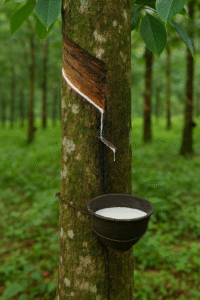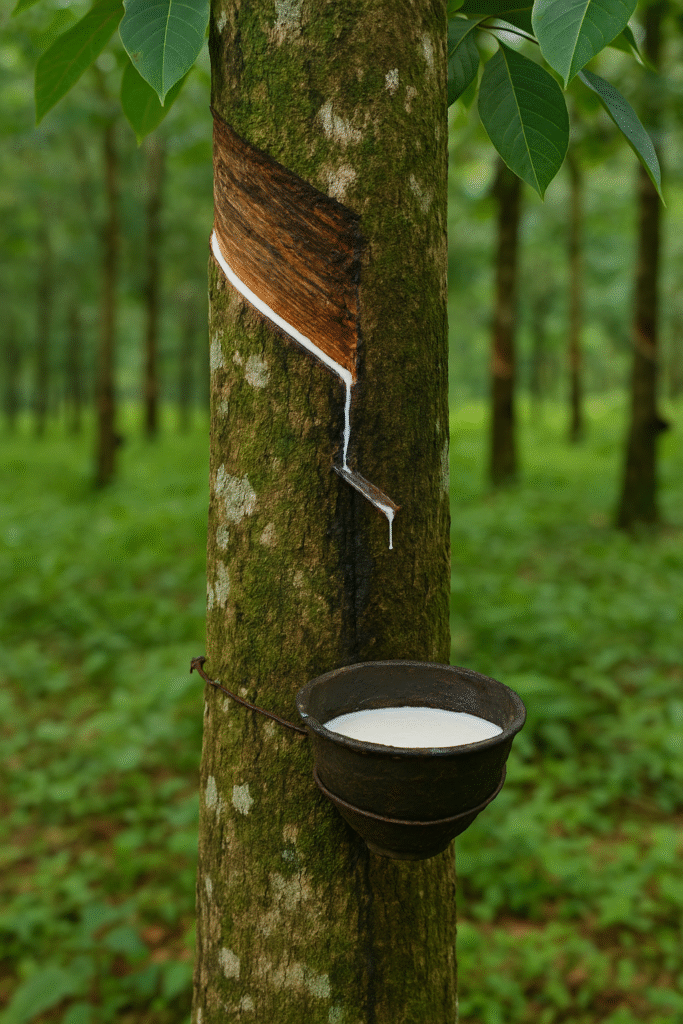The rubber tree, scientifically known as Hevea brasiliensis, is a tropical tree native to the Amazon Rainforest that revolutionized industries across the globe. It is the primary source of natural latex, which is used to make rubber—a crucial material in transportation, healthcare, manufacturing, and even technology.
In this post, you’ll learn what the rubber tree is, where it grows, how latex is harvested, what it’s used for, and how it played a central role in one of Brazil’s most significant historical economic booms: the Rubber Boom.
🌱 Origin of the Rubber Tree
Hevea brasiliensis originates in the tropical regions of South America, especially Brazil, Peru, Colombia, and Bolivia. In Brazil, it grows mainly in the Amazon region, particularly in the states of Acre, Amazonas, and Pará.
This medium-to-large tree can reach up to 30 meters in height. Its leaves are compound, and it produces small flowers. The most valuable part of the tree is its milky white sap—latex—which flows from shallow cuts made in the bark.
🧪 What Is Latex?
Latex is a milky fluid found in special vessels of the tree. When exposed to air, it coagulates into a soft, elastic, waterproof substance—natural rubber. This material is used in:
-
Tires
-
Condoms
-
Footwear
-
Industrial parts
-
Sports gear
It is also biodegradable, making it more environmentally friendly than synthetic rubber derived from petroleum.
🪓 How Latex Is Harvested
Latex is collected through a method called tapping. Workers make a diagonal cut in the tree’s bark, allowing the latex to drip slowly into small cups tied to the trunk.
This technique is non-lethal to the tree and can be repeated for many years, making rubber extraction a sustainable source of income for forest communities.
🏭 The Rubber Boom and Its Historical Importance
From the late 1800s to the early 1900s, Brazil experienced the Rubber Boom, a time when demand for natural rubber skyrocketed due to the industrial revolution and the rise of the automobile industry.
Cities like Manaus and Belém flourished, importing luxury goods from Europe and building extravagant architecture like the Amazonas Opera House. However, this boom collapsed when the British smuggled rubber tree seeds to Asia, establishing large plantations in Malaysia, Indonesia, and Sri Lanka.
Asian countries quickly surpassed Brazil in production due to better resistance to disease and more controlled farming conditions.
🌍 Current Relevance of the Rubber Tree
Although Brazil is no longer the top producer, the rubber tree still plays an important role:
-
Internal production of natural rubber
-
Environmental conservation through sustainable harvesting
-
Income generation for Amazonian and Indigenous communities
-
Research in biotechnology and sustainable materials
Brazilian latex is considered high-quality, especially for medical and specialty uses.
🐞 Fun Facts About the Rubber Tree
-
A single tree can produce up to 50 grams of latex per day
-
The name “rubber” comes from the ability to rub out pencil marks
-
Latex is also used in eco-friendly paints and adhesives
-
The struggle of rubber tappers helped inspire environmental movements, including those led by Chico Mendes
🍃 Environmental Benefits
Rubber trees provide broad canopy shade, help maintain microclimates, and support biodiversity. When planted in agroforestry systems, they assist in reforesting degraded land and serve as a sustainable alternative to deforestation-based farming.
They are a symbol of how economic value can come from keeping the forest standing.
✅ Conclusion
The rubber tree is more than a source of latex. It’s a tree that shaped history, supported communities, and still plays a role in sustainable development today. Preserving and understanding this tree helps protect the Amazon and the future of renewable resources.

🦟 Recommended for Outdoor Living and Camping:
💡 Solar-Powered Bug Zapper – Efficient and Eco-Friendly Mosquito Control
Looking for a smart solution to mosquitoes while enjoying nature? This solar-powered outdoor insect zapper works as a camping lantern, mosquito killer, and portable light, all while being weather-resistant and cordless. Great for gardens, patios, or campsites.
👉 Click here to view the solar bug zapper on Amazon
🌿 Discover the Majesty of the Amazon’s Giant Water Lily
Curious about the largest water lily on Earth? Dive into the fascinating world of the Victoria amazonica, a botanical marvel known as the Queen of Amazonian Waters.

